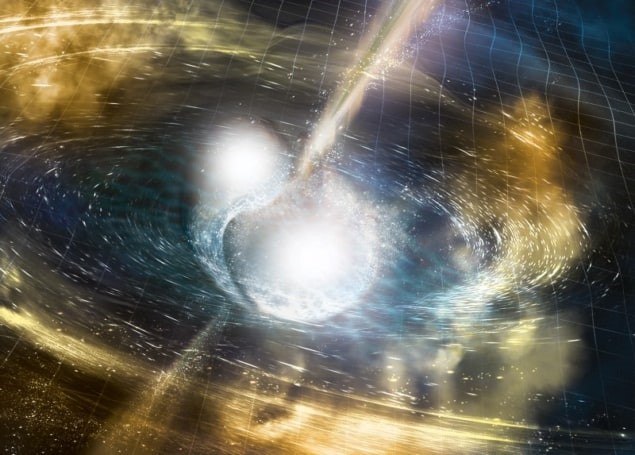
Disclaimer: Copyright infringement not intended.
Context
- Physicists in Japan and Lithuania found evidence that tellurium is produced during neutron star mergers, bolstering the idea that these mergers account for the majority of heavy elements in the universe.
Details
The "R-Process" and Synthesis of Heavy Nuclei
- The "r-process" describes the synthesis of heavy nuclei, occurring in environments with a high density of free neutrons.
- Nuclei capture neutrons at a rapid rate, creating a distribution of neutron-rich nuclei with peaks around specific atomic mass numbers, such as 80, 130, and 196.
Role of Neutron Star Mergers in Heavy Element Formation
- Ejected matter from neutron star mergers leads to kilonovae, events that are as bright as a thousand novae but not as bright as supernovae.
- Abundance patterns in the solar system display characteristic "r-process" peaks, indicating the origin of heavy elements on Earth from this process.
Confirmation of Kilonovae and Spectral Analysis
- The existence of kilonovae was confirmed in 2017 following the detection of gravitational waves from the neutron-star merger GW170817.
- Spectral analysis of GW170817's kilonova revealed absorption signatures of strontium, cerium, and lanthanide elements, indicating the presence of the r-process.
Role of Tellurium in Kilonovae
- Researchers modeled emission lines of heavy elements, predicting a strong emission line at 2.1 micrometers from doubly ionized tellurium, matching an unexplained feature in GW170817's spectrum.
Confirmation from the James Webb Space Telescope (JWST)
- Observations by the JWST of the gamma-ray burst GRB230307A provided further evidence for the occurrence of the r-process in neutron star mergers.
- JWST's infrared spectra showed similarities to GW170817, including the presence of the 2.1 micrometer feature attributed to tellurium.
Significance of Ongoing Observations with the JWST
- The sensitivity of the JWST enabled the detection and analysis of the kilonova in GRB230307A, even though it was significantly farther away than GW170817.
- Continued observations with the JWST aim to unravel the full details of the various nuclei created in these mergers, contributing to a better understanding of the origins of elements in the periodic table.
Introduction to Tellurium
- Tellurium is a chemical element with the symbol Te and atomic number 52.
- It is a brittle, mildly toxic, rare, silver-white metalloid.
- It is a member of the chalcogen group on the periodic table, a group of elements that includes oxygen, sulfur, selenium, and polonium.

Properties of Tellurium
Physical Properties
- Appearance: Silvery-white, crystalline, brittle metalloid
- Density: 6.24 grams per cubic centimeter
- Melting Point: 722.66 Kelvin (449.51 degrees Celsius or 841.12 degrees Fahrenheit)
- Boiling Point: 1,261 Kelvin (988 degrees Celsius or 1,810 degrees Fahrenheit)
Chemical Properties
- Reactivity: It is a moderately reactive element that shows properties similar to sulfur and selenium.
- Solubility: Insoluble in water, but soluble in concentrated sulfuric acid and alkalis.
Occurrence of Tellurium
- Tellurium is one of the rarest elements on Earth, and it is found in the Earth's crust primarily in the form of tellurides of gold and silver.
- It is also present in some copper ores.
- Additionally, tellurium can be found in some rare minerals, such as calaverite, sylvanite, and tellurite.
Uses of Tellurium
- Photovoltaic Industry: It is used in the production of solar panels due to its ability to convert light into electricity.
- Metallurgy: It is used to improve the machinability of copper and stainless steel, and in the production of various types of alloys.
- Rubber Manufacturing: Tellurium is utilized as an accelerator in the curing of rubber.
- Optoelectronics: It is employed in the production of various types of optical storage media, such as CDs, DVDs, and Blu-ray discs.
- Thermoelectric Applications: Tellurium is used in thermoelectric devices to convert waste heat into electricity.
Health and Environmental Effects
- Toxicity: Tellurium and its compounds are considered to be moderately toxic. Exposure to high levels of tellurium can result in various health issues, including garlic-like breath odor, headaches, and even more severe symptoms.
- Environmental Impact: Tellurium pollution can occur through various industrial processes, and its release into the environment can have adverse effects on ecosystems.
Introduction to Neutron Stars
- They are the collapsed cores of massive stars, formed during a supernova explosion.
- Neutron stars are incredibly dense, composed primarily of neutrons, and possess extraordinary gravitational forces.
Characteristics of Neutron Stars
Density and Composition
- Density: Neutron stars are among the densest objects in the universe, with densities that can reach up to 10^17 kg/m³.
- Composition: They are mainly composed of tightly packed neutrons, resulting from the collapse of the core during a supernova event.
Size and Mass
- Size: Neutron stars typically have a radius of about 10-15 kilometers, making them incredibly compact objects.
- Mass: They can have masses that are 1.4 to 3 times that of the Sun, with some even exceeding this range.
Magnetic Field
- Strong Magnetic Fields: Neutron stars possess incredibly strong magnetic fields, typically a trillion times stronger than Earth's magnetic field. This intense magnetic field gives rise to unique astrophysical phenomena.
Formation of Neutron Stars
- Neutron stars are formed when massive stars exhaust their nuclear fuel and can no longer support their outer layers against gravity.
- This results in a supernova explosion, expelling the outer layers and leaving behind a dense core, which collapses under its own gravity to form a neutron star.
Properties and Behavior
Rotation
- Rapid Rotation: Neutron stars often rotate rapidly, sometimes at rates of several times per second, due to the conservation of angular momentum during the collapse.
Pulsars
- Pulsars: Neutron stars with beams of electromagnetic radiation that emanate from their magnetic poles are known as pulsars. These beams are observed as pulses of radiation as the neutron star rotates, leading to their designation as "pulsating stars."
Significance and Research
- They are essential in the study of gravitational waves, the dynamics of stellar evolution, and the behavior of matter under extreme densities.

Conclusion
Tellurium, a rare metalloid element, finds applications in diverse industries, including solar energy, metallurgy, and optoelectronics. While its unique properties make it valuable, careful handling is necessary due to its toxicity.
Neutron stars, with their extreme density and powerful magnetic fields, represent one of the most captivating objects in the universe. They continue to captivate the attention of astronomers and astrophysicists, offering profound insights into the fundamental nature of matter, stellar evolution, and the behavior of matter under extreme conditions.
|
PRACTICE QUESTION
Q. Which of the following statements regarding tellurium is/are true?
- Tellurium is a brittle, silver-white metalloid primarily found in the Earth's crust in the form of tellurides of gold and silver.
- It is commonly used in the photovoltaic industry for the production of solar panels due to its ability to convert light into electricity.
- Tellurium is a highly reactive alkali metal commonly used in the pharmaceutical industry for the production of antibiotics.
a) Only statement 1
b) Statements 1 and 2
c) Statements 2 and 3
d) All of the above
Answer: b)
|
















